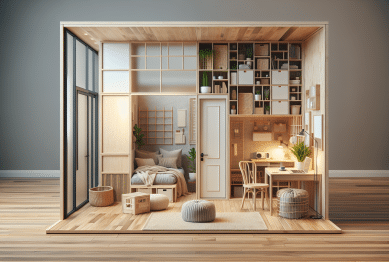Curious how minimalism could change your world? This guide explores how simplifying your lifestyle, decluttering your space, and rethinking your habits can make every day more peaceful and purposeful. Discover the unexpected benefits and learn how to start embracing minimalism at home and beyond.
Rethinking Possessions and Finding Balance
Many people accumulate belongings over years, often without stopping to consider their true need or value. Minimalism encourages a shift in mindset—emphasizing quality over quantity and inviting you to ask what truly serves your happiness. By reducing clutter, the home feels lighter and mental space increases. This process of mindful decluttering isn’t about deprivation. Instead, it helps individuals distinguish between wants and essentials—promoting contentment over constant desire for more. Letting go of excess can be liberating, allowing possessions to become purposeful, not burdensome.
Physical clutter affects mental well-being more than most realize. Research suggests that an organized environment can boost focus and lower stress. Choosing to keep only what is meaningful creates an atmosphere that feels intentional. Each item has a place and tells a story. This brings harmony and ease to daily routines. Gradually, a person experiences less decision fatigue, as there are fewer items to clean, maintain, or organize, freeing up energy for what truly matters. Minimalism doesn’t mean having nothing—it means having just what you need.
The journey toward a minimalist lifestyle often starts with small changes. It can be as simple as sorting a single drawer or donating unused clothes. Each step makes a difference. Over time, these practices spill over into other areas of life—meals, schedules, even digital spaces. The end goal isn’t a pristine home but a balanced life where priorities are clear. Living with less invites you to be present, cultivating gratitude for each object and experience. Minimalism is personal; it adapts to your lifestyle, not the other way around.
Designing a Calmer Home with Minimalist Principles
The home acts as a sanctuary. Minimalist design uses neutral colors, open spaces, and natural light to create a peaceful ambiance. It is centered on functionality and comfort. Furniture with clean lines and multipurpose features blends aesthetics with utility. This simplicity makes tidying up effortless. Minimalist décor often includes plants or artwork sparingly, allowing the space to breathe. The result? A soothing haven that welcomes relaxation and fosters creativity. Many find minimalist interiors help reduce anxiety and make it easier to recharge after busy days.
Decluttering—and then maintaining—a simple home environment can improve the enjoyment of everyday moments. Quality is prioritized over quantity, leading to intentional purchases. Each object serves a role, whether it’s a favorite mug, a one-of-a-kind picture frame, or a cozy reading chair. The less-is-more approach encourages careful consideration before adding anything new. This conscious consumption supports sustainability and personal values. By limiting excess, people notice greater satisfaction and fulfillment from the carefully chosen treasures that remain, making every corner of the home meaningful.
Household organization is easier when items are few and functional. Storage solutions—like baskets or floating shelves—keep spaces visually calm without sacrificing utility. Digital tools assist in staying organized too, from calendar apps to inventory systems for pantry items. Minimalist homes are often easier to clean, saving both time and effort. With less chaos, the mind can rest. Many families discover new enjoyment in shared spaces and develop creative habits, like cooperative cooking or board game nights—as clutter clears, so does the path for joy.
Mindful Consumption and Financial Simplicity
Embracing minimalism invites more thoughtful spending habits. Every buying decision becomes intentional. Instead of succumbing to impulse purchases or sales, minimalists learn to question if something is genuinely needed or simply desired in the moment. Over time, this leads to significant savings. Budgets stretch further, and spending aligns with personal values rather than short-lived fads or advertising pressure. This mindful consumption reduces financial stress and can redirect resources toward meaningful goals—like travel, hobbies, or education.
The principles of minimalism can transform financial planning. Fewer purchases mean more opportunities to build emergency savings, invest in experiences, or even work toward early retirement. Minimalist budgeting isn’t about restriction but about reframing priorities. Many people report less anxiety about money and a greater sense of control over their resources. By focusing on essentials and letting go of excess spending, it’s easier to appreciate what’s already available. This approach fosters financial resilience and ensures spending brings long-term satisfaction rather than fleeting happiness.
Many minimalist advocates recommend strategies like the ‘30-day rule’—waiting before committing to a purchase—or keeping a wish list rather than shopping impulsively. These habits build discipline over time. Minimalism often leads to a decrease in debt and helps individuals identify areas where they can cut back without feeling deprived. The emphasis shifts from material accumulation to experiences, knowledge, and relationships. Simplicity in finances means less paperwork, clearer goals, and a stronger sense of freedom.
Minimalism and Emotional Well-Being
Simplifying daily routines and environments offers mental and emotional benefits. Reducing visual noise helps ease feelings of overwhelm. Many individuals notice lower stress levels and improved mood when their spaces feel uncluttered. Minimalism promotes mindfulness—each day begins with clarity and intention. Decision fatigue lessens as there are fewer choices to make. This peaceful foundation supports better mental health and fosters resilience in the face of life’s challenges.
Minimalist living often leads to greater self-awareness. By stripping away distractions, people discover what truly matters to them—values, passions, and relationships. Less time spent on maintenance creates more time for hobbies, personal growth, and connecting with loved ones. Even small steps, like setting aside digital devices during meals or streamlining morning routines, can help. Over time, these habits strengthen self-discipline and confidence, building a balanced emotional landscape rooted in gratitude and purpose.
Emotional simplicity doesn’t mean life is free from hardship. However, clear spaces make it easier to process emotions and manage stress. Minimalism can improve sleep quality, increase productivity, and support the pursuit of meaningful goals. Some find a deeper connection to nature or spirituality as a result. With each mindful choice, minimalism cultivates a sense of inner calm, encouraging personal growth and well-being over material accumulation.
Minimalism and Sustainable, Conscious Living
One of the less-discussed benefits of minimalism is its impact on the environment. By purchasing less and choosing higher-quality, longer-lasting items, waste is reduced. This supports sustainable living and decreases the burden on landfills. Minimalism encourages the use of reusable goods, eco-friendly products, and thoughtful recycling habits. People become more conscious of their consumption, opting for brands that align with ethical and ecological values. This approach conserves both resources and energy.
Conscious consumption extends beyond products. Minimalists are more likely to conserve water, use public transportation, or practice energy-saving habits at home. Each small act contributes to a larger impact. Community involvement—such as clothing swaps or group cleanups—often follows naturally from the minimalist mindset. Sharing, repairing, and borrowing rather than buying can strengthen local bonds and ignite collective environmental action. Minimalism’s simplicity paves the way for responsible, conscious living that benefits both individuals and the wider world.
Adopting a sustainable lifestyle also provides a sense of contribution to the planet’s future. The joy of minimalism comes from knowing that daily choices have a positive ripple effect. By rejecting overconsumption, people encourage industries to reduce packaging, improve transparency, and innovate for longevity. This cycle feeds back into the minimalist philosophy—when everyone does a little less, it actually achieves a whole lot more. The result is a lifestyle that feels meaningful, intentional, and aligned with broader environmental goals.
Practical Tips to Start Minimalism Today
Starting small is key. Rather than overhauling everything overnight, focus on one drawer, closet, or digital folder. Ask yourself: does this item serve a real purpose? Do you love it or use it regularly? Donate, sell, or recycle what no longer serves you. Some find it helpful to set daily or weekly goals for decluttering, tracking progress to stay motivated. Minimalism is a journey, not a destination—celebrate each step forward.
Create habits that support simplicity. Limit the inflow of new possessions by adopting the ‘one in, one out’ rule. For every new purchase, let go of a similar item. Schedule regular times for digital cleanups—unsubscribe from unnecessary emails, organize files, and remove unused apps. Invest in objects with lasting quality or sentimental value. Surround yourself with items and people that nourish your growth and reflect your priorities. Remember, minimalist living adapts to your unique circumstances.
Minimalist communities offer inspiration and support. Look for blogs, podcasts, or local groups focused on simple living. Learning from others’ experiences can spark ideas and provide practical advice. Keep exploring resources, but always adapt suggestions to work for you. Minimalism is about crafting a life that feels light, purposeful, and satisfying—not about following strict rules. With intention and patience, anyone can unlock the everyday magic of living with less.
References
1. Morrow, A. (n.d.). Decluttering and mental health: A review. Retrieved from https://www.ncbi.nlm.nih.gov/pmc/articles/PMC7285951/
2. Keltner, D. (n.d.). The psychology of home organization. Greater Good Science Center, University of California, Berkeley. Retrieved from https://greatergood.berkeley.edu/article/item/the_psychology_of_home_organization
3. Becker, J. (n.d.). What is minimalism? Becker’s perspective. Becoming Minimalist. Retrieved from https://www.becomingminimalist.com/what-is-minimalism/
4. Mindful. (n.d.). Minimalism and mindfulness: Living with intention. Mindful Magazine. Retrieved from https://www.mindful.org/minimalism-and-mindfulness-living-with-intention/
5. Environmental Protection Agency. (n.d.). How sustainable living helps reduce waste. Retrieved from https://www.epa.gov/recycle
6. The Minimalists. (n.d.). Tips for minimalism beginners. Retrieved from https://www.theminimalists.com/start/









